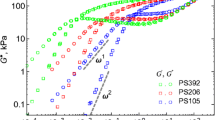Abstract
Shear stress and first normal stress difference relaxation data were measured for a range of shear strains using three polymers: polystyrene (PS) with narrow molecular weight distribution, PS with large polydispersity index (PI), and a commercial polyethylene, HDPE, with large PI. From these experiments a damping function, h(γ), for each polymer was determined and compared with theoretical predictions of the recent force balanced network (FBN) model proposed by Marrucci et al. [1, 2]. For comparison purposes the data were also compared with Doi and Edward [3] theory. Both models were found to overestimate the shear softening of h(γ). Nevertheless, a somewhat better description of the observed behavior was obtained with the FBN model without using any adjustable parameter.





Similar content being viewed by others
References
Marrucci G, Greco F, Ianniruberto G (1999) Macromolecular symposium
Marrucci G, Greco F, Ianniruberto G (2000) J Rheol 44:845–854
Doi M, Edwards SF (1986) The theory of polymer dynamics. Clarendon Press, Oxford
Bird RB, Armstrong RC, Hassager O (1977) Dynamics of polymer liquids, vol 1. Wiley, New York
Larson RG (1988) Constitutive equations for polymer melts and solutions. Butterworths, Boston
Kay A (1962) College of Aeronautics, Crandford, Note No. 134. Bernstein B, Kearsley EA, Zapas LJ (1963) Trans Soc Rheol 7:391
Lodge AS, Meissner (1972) Rheol Acta 11:351–352
Wagner MH (1976) Rheol Acta 15:136–142
Wagner MH, Ehrecke P (1998) J Non-Newtonian Fluid Mech 76:183–197
Dealy JM, Wissburn KF (1990) Rheology and its role in plastics processing. Theory and applications. Van Nostrand Reinhold, New York
Papanastasiou AC, Scriven LE, Macosko C (1983) J Rheol 27:387–410
Zapas LJ (1966) J Res Nat Bur Stds 70A:525–532
Adams EB, Bogue DC (1970) AIChE J 16:53–57
Soskey PR, Winter HH (1984) J Rheol 28:625–645
Osaki K, Nishizawa K, Kurata M (1982) Macromolecules 15:1068–1071
Osaki K (1993) Rheol Acta 32:429–437
Larson RGJ (1984) Rheol 28:545
Aoki Y, Hatano A, Watanabe H (2000) XIIIth International congress on rheology. Cambridge, UK
Acknowledgements
This work was financially supported by the NSERC (Natural Sciences and Engineering Research Council of Canada), Canada Research Chair on Polymer Physics and Nanomaterials and Steacie fellowship grants.
Author information
Authors and Affiliations
Corresponding author
Rights and permissions
About this article
Cite this article
Iza, M., Bousmina, M. Damping function for narrow and large molecular weight polymers: comparison with the force-balanced network model. Rheol Acta 44, 372–378 (2005). https://doi.org/10.1007/s00397-004-0419-y
Received:
Accepted:
Published:
Issue Date:
DOI: https://doi.org/10.1007/s00397-004-0419-y




